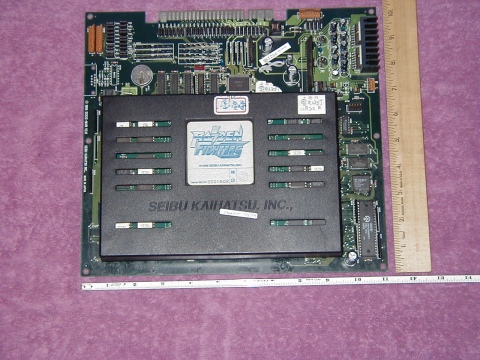 The Seibu SPI System is a powerful piece
of arcade hardware. It has excellent 2D graphics capabilities and a digital
sound system. The core CPU in this hardware is an Intel 386DX CPU. It typically
runs at a clock speed of 25MHz. It can run up to 33MHz for later Seibu
SPI games like Raiden Fighters Jet. The games are contained into separate
daughterboard cartridges. This means that you can interchange different
games on one Seibu SPI board. The YMF271 is an undocumented Yamaha chip.
It is sample based, and apparently can load 8 and 16 bit samples of various
formats, but no stereo samples though. It has at least 8 channels polyphony,
similar to the ADPCM chip used in Cave games such as Dodonpachi, and probably
no FM capability (not proven yet). The Seibu SPI System is a powerful piece
of arcade hardware. It has excellent 2D graphics capabilities and a digital
sound system. The core CPU in this hardware is an Intel 386DX CPU. It typically
runs at a clock speed of 25MHz. It can run up to 33MHz for later Seibu
SPI games like Raiden Fighters Jet. The games are contained into separate
daughterboard cartridges. This means that you can interchange different
games on one Seibu SPI board. The YMF271 is an undocumented Yamaha chip.
It is sample based, and apparently can load 8 and 16 bit samples of various
formats, but no stereo samples though. It has at least 8 channels polyphony,
similar to the ADPCM chip used in Cave games such as Dodonpachi, and probably
no FM capability (not proven yet).
The Seibu SPI was once thought to employ some nasty encryption
and protection schemes, as well as a suicide feature. This has been proven incorrect recently. The game
program ROMs and the graphic object ROMs are encoded using byte-by-byte
interleaving (which is why some people were unsuccessful in finding x86 code
directly from the program ROMs). The much-talked about Dallas MCU chip on the SPI board turned out
to be nothing more than an RTC (Real-Time Clock). The battery on the SPI mainboard is not a suicide
battery. If the battery was a suicide battery,
what would be there to kill? There's no game or boot program to kill on
the SPI board. The game cartridges don't contain any battery, and that's
the only SPI component that has any program at all. Even the English Fabtek
manuals for the SPI games state that the boards come with a "battery-backed
memory." This memory stores such information as bookkeeping records, high
score tables, and other features like the time-release of Raiden Fighters
2. The CR-2032 battery doesn't appear to be soldered onto the board; it
seems that it can be easily replaced. Also, it seems that the board will
run with a dead battery.
-Thanks go to chimpmeister for providing
information and pictures about the Seibu SPI hardware. Thanks also go to
the Swiss Collectors and ZeroKnightRaiden for additional SPI information. |